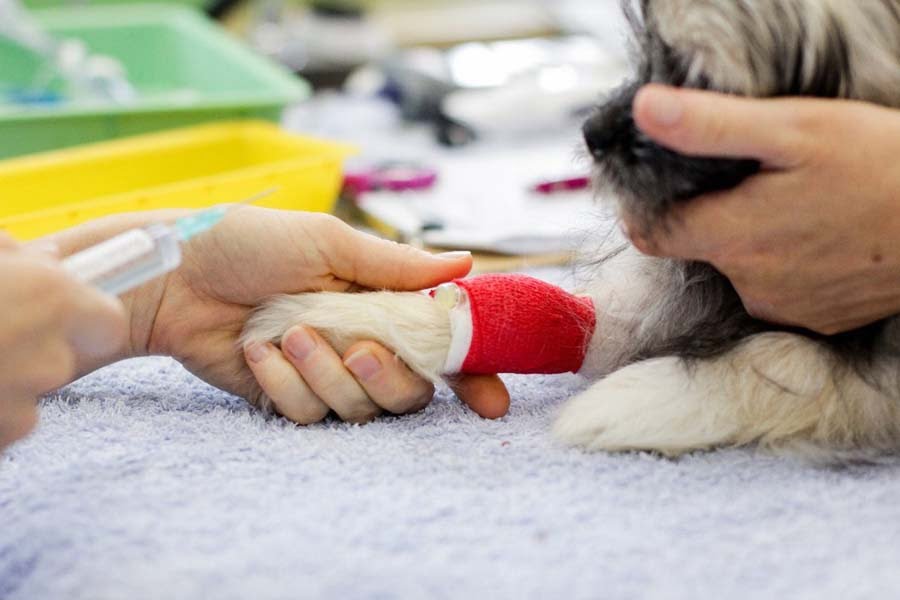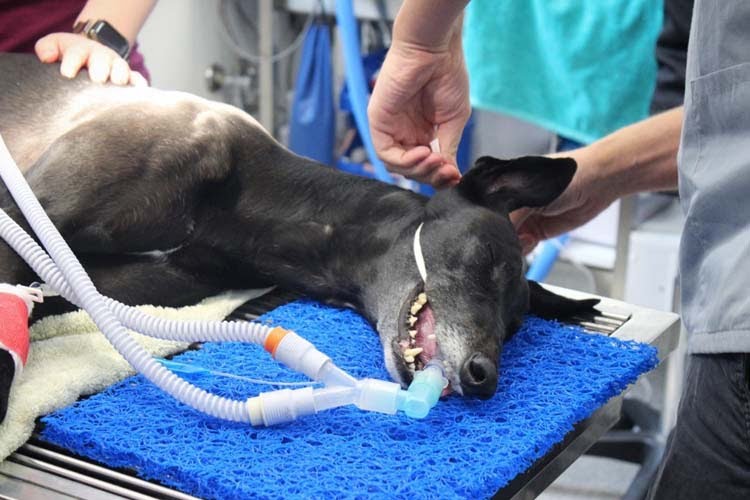A Turramurra Vet Pet Care Article
Intravenous Fluid Therapy

Intravenous Fluid Therapy
by Freya Britt-Lewis, Pet Health Care Writer
Intravenous fluid therapy is commonly used for a whole host of clinical problems, as well as during procedures requiring anaesthesia. The fluids are administered via an intravenous catheter. A catheter is a sterile tube put into a peripheral vein that allows the administration of various types of fluids, medications and anaesthetic induction agents.
Our veterinarians use an intravenous catheter placed in the leg to funnel a continuous drip of fluids directly into the bloodstream. This procedure is not painful, with patients being moved to a comfortable hospital bed and allowed to relax as soon as possible after placement. If needed they will receive oral or injectable medications alongside the fluid therapy.
When would we use intravenous fluid therapy?
IVF is used as supportive therapy in veterinary medicine and surgery when treating many different medical conditions as well as to keep our animal patients hydrated with a normal blood pressure.
Below are examples of some of the conditions where IVF is utilised in veterinary practice:
- Anaesthesia
- Dehydration
- Kidney or liver disease
- Vomiting
- Severe diarrhoea
- Pancreatitis
- Toxicities
- Trauma
- Shock
- Low blood pressure
- Bleeding disorders
The use of intravenous fluid therapy throughout an anaesthetic procedure will aid in faster metabolism of anaesthetic agents, maintenance of normal blood pressure and therefore, a speedier recovery.
At Turramurra Veterinary Hospital, Intravenous Fluids is routine during all surgical and dental procedures involving anaesthesia.

Molly the Greyhound has intravenous fluids during her dental procedure under anaesthesia
What are the benefits of intravenous fluid therapy?
The use of IV fluids allows for fast hydration, medication absorption and assists with toxin removal. Additionally, IV fluids can be used to effectively rehydrate an animal that is vomiting or needs stabilisation before a surgery procedure in a sick pet, for example, if there is a gastrointestinal foreign body obstruction. It is not invasive or painful for the animal and generally stress-free, with a rapid response to treatment in most cases.
Here are a couple of examples where IV fluids are used in specific medical cases in veterinary practice:
Kidney disease
Your pet’s kidneys are designed to filter the “good” from the “bad” as blood travels through microscopic filters called glomeruli. Waste chemicals and toxins will be taken through to the urinary tract, with desirable materials such as water (as needed to maintain hydration), sugar, certain electrolytes and proteins being circulated back into the blood stream. This is a very important function to maintain optimum health.
Over time, as our pets age, the kidneys will naturally lose some of this efficiency and as kidney function reduces, your pet may need to drink more water over time to compensate. This is known as chronic kidney disease If your pet is left without water or accidentally knocks it over, your older pet’s less functional kidneys will be unable to resorb water and your pet may become dangerously dehydrated, which in turn can further damage the kidneys. IV fluids in these instances can support the kidneys to prevent further deterioration and rehydrate your pet.
Sometimes the kidneys can be damaged suddenly by a toxin such as accidental ibuprofen, grape/sultana/raisin ingestion in dogs or lily plant ingestion in cats. This can lead to acute kidney disease, which needs urgent veterinary attention, including the use of intravenous fluids, to support the kidneys in filtering out the toxin.
Hypovolaemic shock
Hypovolaemic shock occurs when the blood volume shrinks to a dangerous level either due to water loss or blood loss. This means the blood pressure drops and can have dangerous and potentially life-threatening effects on the heart.
Examples of causes of hypovolaemic shock are:
- Pancreatitis
- Vomiting
- Trauma
- Bleeding
- Haemorrhagic gastroenteritis
- Toxicity
- Dehydration
IV fluid therapy in these instances, involves giving fluid at a much higher rate to save an animal’s life to avoid cardiopulmonary arrest. This is known as a bolus of fluids (fast administration) and is a common life-saving treatment.
How is my pet monitored while receiving intravenous fluids?
Pets on fluids need to be monitored to ensure that their catheters are secure and flushing properly and to make sure that they do not decide to remove themselves from their drip!
It is also important to monitor a pet’s electrolyte levels with regular blood testing and regularly assess their hydration status to enable adjustments to fluid rate and type according to the patient’s needs.
Blood pressure is often monitored in pets receiving treatment for hypovolaemic shock.
How long will my pet need intravenous fluids for?
This is variable depending on a number of factors including the underlying problem, response to therapy and severity of disease. Each patient is assessed and a fluid therapy program catered for that individual’s needs. There is no ‘one size fits all’ policy when it comes to fluid therapy and so your veterinarian will create a fluid therapy plan for each case.
As always, please call your veterinarian if you are in any way concerned for your pet’s health.

